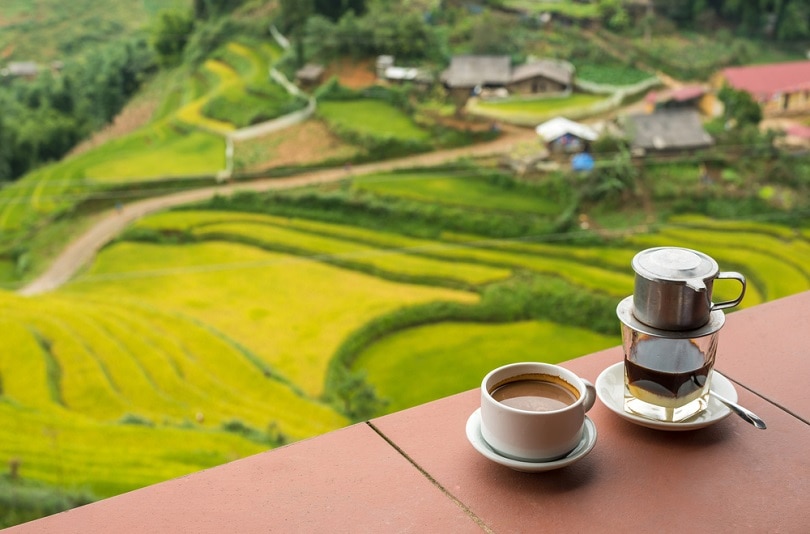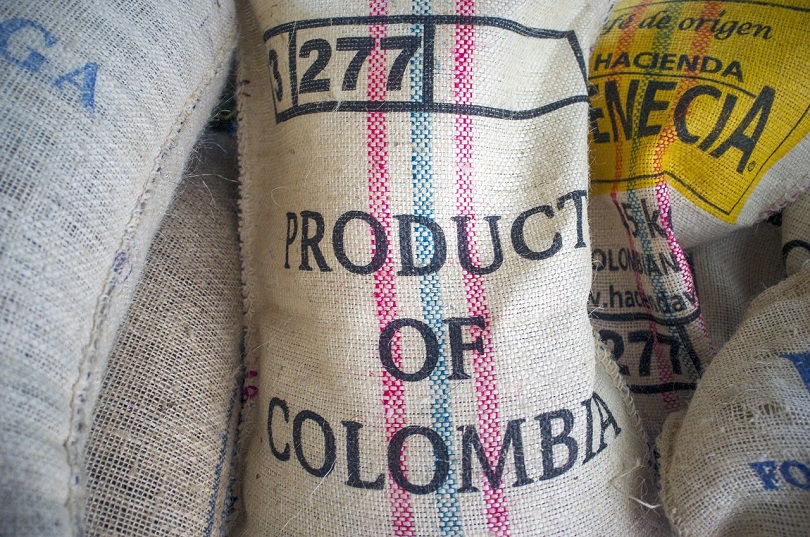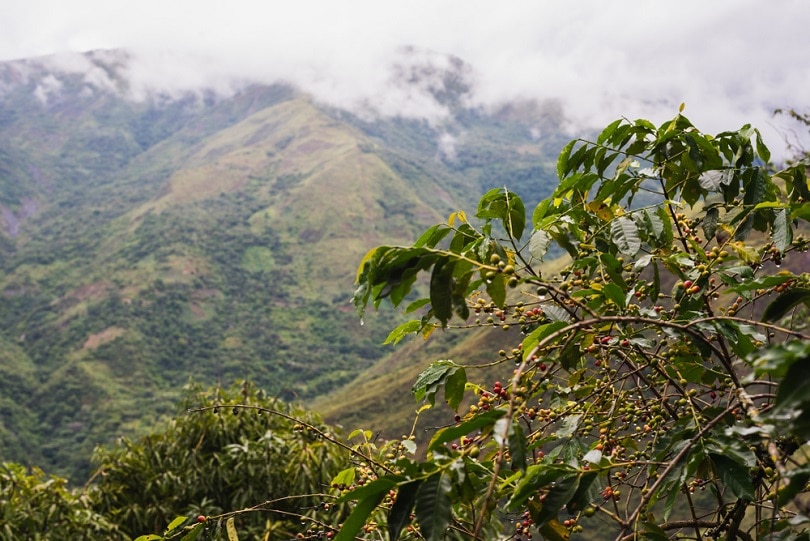
The coffee-producing industry is one of the most competitive globally, especially in areas like South America and Africa. Some countries rely heavily on their ability to produce coffee, creating jobs for thousands of farmers each year. Knowing where your coffee comes from is essential, with some specialty blends only being available in select countries. While there are quite a few countries that grow and harvest coffee beans, only a handful of countries are considered the best in the world. Here are the top 15 coffee-producing countries in the world:

Top 15 Coffee-Producing Countries in the World:
1. Brazil

- Coffee production: approx. 5.7 billion pounds
Brazil is the king of the coffee production industry, exporting around 2.6 million metric tons of coffee annually. Around 70% of the coffee beans from Brazil are Arabica beans, with some regions growing the stronger, bitter Robusta bean. There’s quite a large chance that the coffee you’re drinking is from Brazil unless it’s a specialty blend from a specific country or single-origin coffee.
2. Vietnam

- Coffee production: approx. 3.6 billion pounds
Vietnam comes in second in coffee production, exporting a whopping 1 million metric tons of coffee. Nearly all of the coffee beans they produce are the Robusta bean, grown at elevation in the Central Highlands. Though political strife, environmental factors, and economic problems cause their coffee production to fluctuate, Vietnam remains in second place in the top coffee-producing countries.
3. Colombia

- Coffee production: approx. 1.7 billion pounds
Colombia is a strong competitor in the coffee exportation industry, usually producing over 800,000 metric tons of coffee. They produce some of the best-tasting coffee in the world, with farming regions at high and low altitudes to create a wide variety of coffee flavor profiles. Since Colombia has been farming coffee for over 200 years, the methods of producing high-quality beans are near-perfect.
4. Indonesia

- Coffee production: approx. 1.4 billion pounds
Indonesia is another powerhouse of coffee production, getting close to matching Colombia in terms of coffee bean weight. Indonesia is also famous for the most unique coffee processing method in the world. Palm civets (monkey-like mammals) eat the coffee cherries and defecate the coffee beans inside the fruit, which are then harvested. Called Kopi Luwak coffee, it’s one of the most expensive coffees in the world.
5. Ethiopia

- Coffee production: approx. 846 million pounds
Ethiopia is the origin of the coffee plant and farming the native plants goes back centuries, way before the explosion of coffee production in South America. The leading African country in the coffee-producing industry, Ethiopia’s economy is heavily influenced by the amount of coffee sold yearly. The coffee in Ethiopia is also some of the highest-quality coffee in the world, especially if it’s a single-origin bean.
6. Honduras

- Coffee production: approx. 767 million pounds
Honduras has floated around the list of top coffee-producing countries, sometimes getting up to 5th place. Coffee is grown in multiple regions of Honduras, though the high elevations in the mountains produce the best-tasting coffee beans. Coffee farming and selling is a major part of the economy in Honduras, as well as a multigenerational business for farming families.
7. India

- Coffee production: approx. 767 million pounds
Right on the tail of Honduras, India is another coffee-producing powerhouse in the industry. Mostly farmed in three states in the southern area, the region Karnataka is responsible for nearly 65% of all coffee produced in India. Farms in India produce mostly Robusta beans, but there are some farms increasing their Arabica yields due to the global demand for it.
8. Uganda

- Coffee production: approx. 634 million pounds
Coming in second to Ethiopia in coffee production, Uganda’s number one exported crop is coffee. Introduced from Ethiopia, Uganda has a lot of mixed-crop farms that grow Arabica beans alongside other crops. Robusta is also grown in the Lake Victoria Basin, which tends to be easier to grow and more stable as a cash crop.
9. Mexico

- Coffee production: approx. 515 million pounds
Known as the number one export of organic coffee beans, Mexico’s small farms produce some of the highest-quality coffee that is also organic. These small farms are run by families, generally located in the Oaxaca and Chiapas regions. Arabica beans are 95-95% of the total amount produced, which are grown in the shade and produce a unique taste from the cooler temperatures.
10. Guatemala

- Coffee production: approx. 449 million pounds
Guatemala produces around 204,000 metric tons of coffee annually, grown in a handful of key regions. The Antigua region creates the most sought-after specialty coffee bean, known for its volcanic soil and somewhat predictable weather. Almost all the coffee in Guatemala is Arabica and grown in the shade. Each region has its own signature flavor profile due to the changes in temperature and elevation.
11. Peru

- Coffee production: approx. 423 million pounds
Peru is another South American country that produces some of the best coffee beans in the world, with most of it coming from the Cajamarca region. Coffee production is incredibly crucial to the economy, and it’s one of Peru’s top exported crops. Peruvian coffee has a similar flavor profile to other South American coffee beans, with more chocolate and nutty tones that make it stand out.
12. Nicaragua

- Coffee production: approx. 291 million pounds
Coffee production in Nicaragua is essential to the economy and the lives of millions, which is due to coffee being their dominant exported crop. Coffee from Nicaragua is unique in that it’s closer to Ethiopian coffee, which is lighter and more delicate in flavor than other South American beans. Most coffee in Nicaragua is grown on small farms, using the natural process to harvest the beans.
13. China

- Coffee Production: approx. 257 million pounds
While they import a lot of coffee from Vietnam, China also exports a decent amount of coffee as well. Yunnan is the dominating region that produces over 95% of China’s total coffee production, which has a similar climate to South American countries. Although it wasn’t always a coffee country, each year, the amount of coffee produced in China seems to rise.
14. Ivory Coast

- Coffee Production: approx. 238 million pounds
Located in West Africa, Ivory Coast is a major exporter of coffee in Africa and a huge part of the country’s economy. Ivory Coast coffee is often called Cote D’Ivoire coffee due to its history with French colonization. The Ivory Coast produces mostly Robusta beans in favor of Arabica beans. Unfortunately, the overall coffee production has steadily declined over the decades.
15. Costa Rica

- Coffee Production: approx. 197 million pounds
Costa Rica has a rich history steeped in coffee farming and production, which is also essential to their economy. Mostly growing and harvesting Arabica beans, Costa Rican coffee is dependable for its overall good quality. Costa Rica uses honey to process their coffee beans, a method that is quite rare and increasing in popularity among other coffee-producing countries.
Featured image credit: Alehandra13, Pixabay















